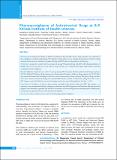Please use this identifier to cite or link to this item:
https://hdl.handle.net/20.500.14356/1459Full metadata record
| DC Field | Value | Language |
|---|---|---|
| dc.contributor.author | Sarraf, Deependra Prasad | - |
| dc.contributor.author | Rauniar, Gajendra Prasad | - |
| dc.contributor.author | Chhetri, Roshan | - |
| dc.contributor.author | Kafle, Shyam Prasad | - |
| dc.contributor.author | Marahatta, Suchana | - |
| dc.contributor.author | Khanal, Basudha | - |
| dc.contributor.author | Sharma, Sanjib Kumar | - |
| dc.contributor.author | Kattel, Vivek | - |
| dc.date.accessioned | 2023-05-14T06:15:36Z | - |
| dc.date.available | 2023-05-14T06:15:36Z | - |
| dc.date.issued | 2020 | - |
| dc.identifier.citation | SarrafD. P., RauniarG. P., ChhetriR., KafleS. P., MarahattaS., KhanalB., SharmaS. K., & KattelV. (2021). Pharmacovigilance of Antiretroviral Drugs at B.P. Koirala Institute of Health sciences . Journal of Nepal Health Research Council, 18(4), 596-603. https://doi.org/10.33314/jnhrc.v18i4.2634 | en_US |
| dc.identifier.issn | Print ISSN: 1727-5482; Online ISSN: 1999-6217 | - |
| dc.identifier.uri | http://103.69.126.140:8080/handle/20.500.14356/1459 | - |
| dc.description | Original Article | en_US |
| dc.description.abstract | Abstract Background: Antiretroviral drugs are lifeline for patients living with HIV. Adverse drug reactions can compromise the compliance to antiretroviral therapy. The objectives of the study were to estimate the prevalence of adverse drug reactions and to assess its risk factors in patients living with HIV and receiving antiretroviral therapy. Methods: A prospective cohort study was conducted among 496 patients living with HIV at B.P. Koirala Institute of Health Sciences for a period of one year. Adverse drug reactions were evaluated based upon clinical history, clinical examination and investigations. Results: Majority of patients were of 31-45 year age group (58.1%) and on first-line antiretroviral therapy regimen (94.3%). Total of 240 adverse drug reactions were documented. Prevalence of adverse drug reaction was 34.7%. Skin rash, anemia and nausea and vomiting were the three most common adverse drug reactions. The adverse drug reactions were more common in patients having non-communicable diseases, chronic co-infections, taking more than 3 non-HIV drugs, second and third-line antiretroviral regimen and it was statistically significant (P-value < 0.05). Conclusions: Prevalence of adverse drug reaction was high in the patients living with HIV. Age, gender, co-infections, non-communicable diseases, taking more than three non-HIV drugs and second and third-line antiretroviral regimen were identified as possible risk factor for occurrence of adverse drug reactions and their prior identification is important to optimize the best suited antiretroviral regimen. Keywords: Adverse drug reactions; antiretroviral therapy; pharmacovigilance | en_US |
| dc.language.iso | en | en_US |
| dc.publisher | Nepal Health Research Council | en_US |
| dc.relation.ispartofseries | Oct-Dec, 2020;2634 | - |
| dc.subject | Adverse drug reactions | en_US |
| dc.subject | Antiretroviral therapy | en_US |
| dc.subject | Pharmacovigilance | en_US |
| dc.title | Pharmacovigilance of Antiretroviral Drugs at B.P. Koirala Institute of Health sciences | en_US |
| dc.type | Journal Article | en_US |
| local.journal.category | Original Article | - |
| Appears in Collections: | Vol. 18 No. 4 (2020): Vol. 18 No. 4 Issue 49 Oct-Dec 2020 | |
Files in This Item:
| File | Description | Size | Format | |
|---|---|---|---|---|
| 2634-Manuscript-19985-1-10-20210122.pdf | Fulltext Download | 283.76 kB | Adobe PDF |  View/Open |
Items in DSpace are protected by copyright, with all rights reserved, unless otherwise indicated.
